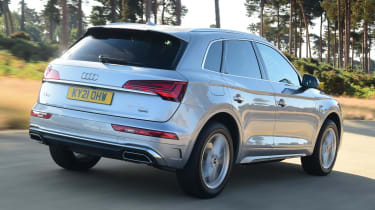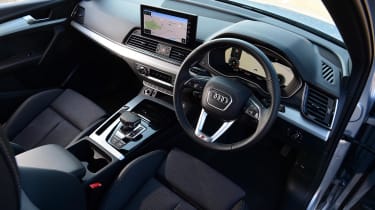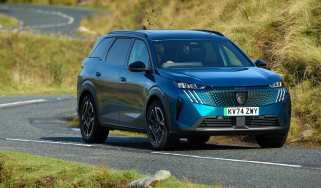Audi Q5 hybrid review
The Audi Q5 TFSI e is a fast and spacious plug-in hybrid SUV capable of covering up to 37 miles on electric power alone, but like its rivals, it has a hefty price tag
Pros
- Practical yet posh family SUV
- Quiet and comfortable
- Smart, solid interior
Cons
- Quite pricey
- Lack of cable storage
- Other PHEVs go further on battery
| Model | Electric range | Fuel economy | CO2 emissions |
|---|---|---|---|
| 50 TFSI e | 37 miles | 166-188mpg | 35-39g/km |
The Audi Q5 is a desirable premium SUV because it offers excellent ride comfort, predictable handling, and a plush interior. The addition of a plug-in hybrid powertrain only improves this package with higher fuel economy, lower emissions and increased performance to challenge rivals such as the BMW X3 xDrive30e, Mercedes GLC 300 e, Lexus NX 450h+, Volvo XC60 Recharge and other premium plug-in hybrid SUVs.
Both the regular Q5 and more stylish Q5 Sportback are available in 50 TFSI e plug-in hybrid form, using a 2.0-litre, four-cylinder turbocharged petrol engine and 141bhp electric motor, drawing power from a 17.9kWh (14.4kWh useable) battery. It features a seven-speed dual-clutch automatic transmission and Audi's quattro four-wheel-drive system. A more powerful 55 TFSI e used to be offered, but the 50 TFSI e's 295bhp and 450Nm of torque should be more than enough for most.
In pure-electric 'EV' mode, the plug-in Q5 is impressively quiet, with well-insulated suspension and tyre noise and virtually no din from the electric motor. According to Audi, you can cover up to 37 miles on electric power alone, and it can get the Q5 up to motorway speeds without needing the engine.
As with all plug-in hybrids, charging the Q5 is critical to achieving its claimed 166.2mpg fuel economy. If you don't plug it in, you'll see this SUV return figures closer to 30-40mpg. Thankfully, charging is easy, with a 7kW home wallbox charger capable of topping up the battery in roughly two and a half hours.
You'll struggle to notice the switch between the electric and petrol power sources – it's seamless with no hesitation or odd changes in throttle response. On top of that, the Q5's ride is pretty comfortable, even on 19-inch alloy wheels with firmer S line suspension. However, you might want to try the top-of-the-range Black Edition first before buying because its larger 20-inch wheels may make the ride uncomfortable on poorly maintained roads.
Passenger and boot space is on par with the plug-in Q5's rivals from BMW, Mercedes and Volvo. Boot space is reduced by 85 litres compared to the petrol and diesel variants. Still, at 465 litres with the seats up (455 for the Sportback due to its sloping rear end), there's plenty of room for a family's kit. Standard equipment on the Q5 is also good, with even the entry-level Sport getting LED headlights, heated and power-adjustable front seats, a 10.1-inch touchscreen, Audi's Virtual Cockpit driver's display, and Apple CarPlay and Android Auto smartphone connectivity.
However, that does come at a price – the cheapest 50 TFSI e model starts at nearly £54,000, while the Black Edition trim comes in at closer to £58,000 – around £6,000 - £7000 more expensive than an equivalent non-electrified diesel or petrol Q5. Opting for the Sportback will also increase the price by around £2,500. Audi has done away with individual options in favour of expensive option packs, so you'll be forced to pay more for additional equipment because an item you desire is bundled into a pack. Company car drivers should consider the Lexus NX 450h+ and recently updated Volvo XC60 plug-in hybrid because both have superior fuel economy, electric driving range figures, and a generous amount of standard equipment.
Overall, the Q5 still manages to suit almost every need. It's fast, roomy, quiet, and has an enviable brand swagger. It's not the cheapest SUV, but it has an underlying quality that means you won't feel shortchanged. For more on the Q5 hybrid, read for the rest of our in-depth review…





